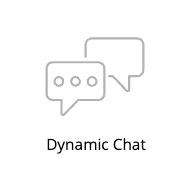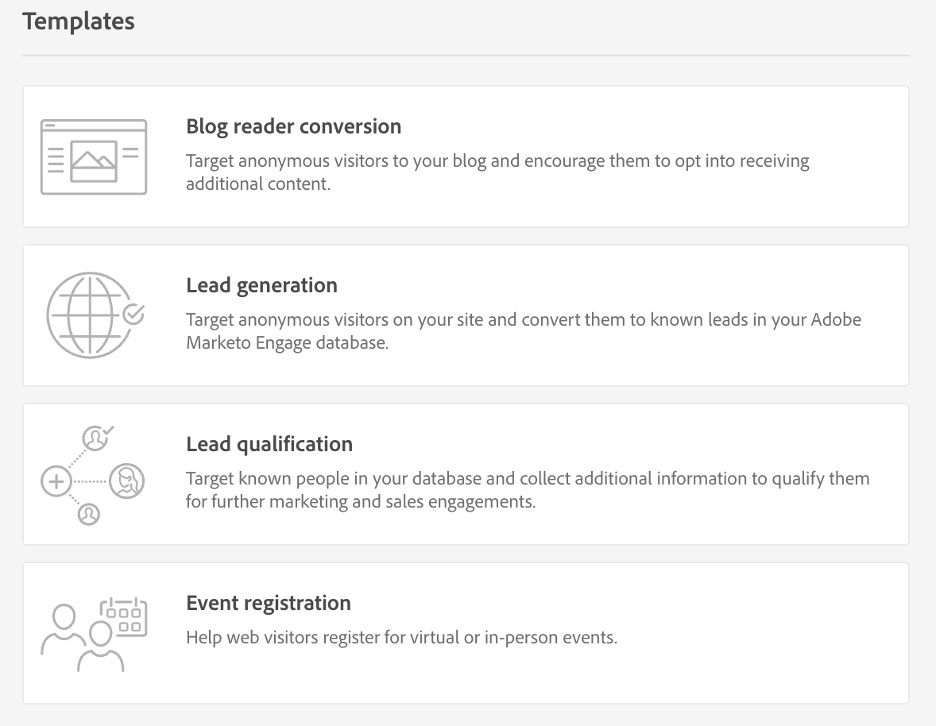Overview
Over the past several years marketing operations practitioners have started hearing about Dynamic Chat and chatbots in general. Adobe Marketo Engage customers can leverage this new feature to engage their prospects and customers in a personalized, curated way. In this blog we share how to get started with Dynamic Chat.
Marketo’s Entry into Chatbots
Dynamic Chat is a new component of Adobe Marketo Engage that has been rolling out to all instances at no additional cost. It’s a highly integrated automated chatbot tool used to apply a conversational marketing style to the website user experience.
 It appears as a tile on the My Marketo dashboard for users once access has been granted through Adobe Admin Console and lives within the Adobe Experience Cloud interface. Because there is a native integration with marketing automation platform data, it makes it easy to target specific audience members with relevant content. This Marketo chat tool offers automated content paths and meeting booking capabilities at this point in time.
It appears as a tile on the My Marketo dashboard for users once access has been granted through Adobe Admin Console and lives within the Adobe Experience Cloud interface. Because there is a native integration with marketing automation platform data, it makes it easy to target specific audience members with relevant content. This Marketo chat tool offers automated content paths and meeting booking capabilities at this point in time.
Connecting with Users in their Preferred Way
Having a cohesive cross-channel marketing experience is critical – and expected – for a good user experience. Chatbots are one way to extend the website experience to engage users in their preferred way and give them personalized guidance while adhering to the brand look and feel and messaging style.
Dynamic Chat can integrate with Outlook or Google calendars to help eager prospects connect with a team member at a time that is convenient for them and that the team member is available. This feature removes barriers for highly engaged users – they don’t have to submit a contact/request form, wait for a response and then have multiple emails back and forth to find a time that works for both parties. This is a win for everyone.
Low-Investment Marketing Exercise
As soon as Dynamic Chat is available in a Marketo Engage instance, the team can begin experimenting with the tool. Specific initiatives that can benefit from this additional channel include lead generation and event promotion; these can serve as prompts for the use of Dynamic Chat. Thankfully, an organization’s use of Dynamic Chat can start small with minimal time and effort, and scale up in response to proven returns.
Planning and Executing Dialogues
The Dynamic Chat JavaScript snippet needs to be added to the website and/or Marketo Engage landing pages before the chatbot can appear on the page. This is most efficiently accomplished through a tag manager such as Google Tag Manager or Adobe Experience Platform Launch.
To begin, the team should determine which scenario/visitor type they’d like to address first and develop a Dynamic Chat dialogue around it. Components to consider include:
- The traits of the target audience – what Marketo field values would be used to identify those Marketo-cookied visitors (or would you want to target anonymous visitors?) Note: Up to 50 person and company fields can be synced between Marketo and Dynamic Chat, and this is done on the instance level.
- On what page(s) the chatbot should appear based on the likely browsing experience of this group
- What existing marketing content (facts, webpages, PDF guides/whitepapers, etc.) would be most relevant to the audience based on their needs and knowledge gaps
This plan will guide the building out of the dialogue in the Dynamic Chat canvas. It comes with several templates to quick-start dialogues for specific use cases:

Dialogue streams can include:
- Messages without a response required, to share greetings and general information
- Questions with response options for the visitor to select from. This enables path splitting to continue with the most relevant content
- Embedded PDFs, which allow for document engagement tracking such as number of pages viewed
- Information capture to collect email, phone or free-form text from the visitor
- Appointment scheduler to book time directly with a team member
To leverage the data from users’ engagement with the chatbot, you’ll want to set up Marketo Engage programs to listen for and track visitor responses and meetings booked through the dialogue. This information can be used to measure chatbot effectiveness to help you improve the experience for website visitors and also as part of operational programs such as behavior scoring and lifecycle processing.
After you’ve built your first dialogue and published it to your website, you can begin planning your next Dynamic Chat dialogue. Don’t worry about potential overlap between audiences or pages – you’ll have the ability to prioritize dialogues so the visitor has the most relevant experience.
Web & Marketing Team Responsibilities
Marketing operations, or in collaboration with the team that manages Adobe Admin Console, enables Dynamic Chat for users and grants access. The web development or IT team will need to be looped in to add the necessary script to the website. Last, but definitely not least, marketing team members – or perhaps marketing operations specifically – will develop the audiences, dialogues and stream content.
Conclusion
Dynamic Chat extends the capabilities of Marketo Engage, providing teams with a simple way to enter the marketing chat channel. Organizations have the opportunity to dip their toe into chatbots with this new feature, offering their website visitors an engaging new way to interact with content.







